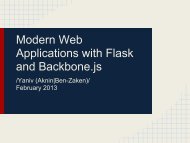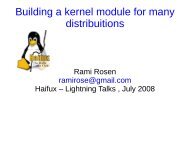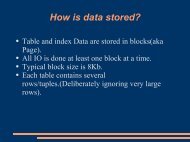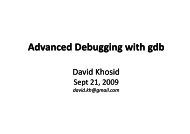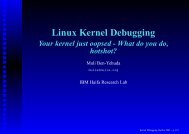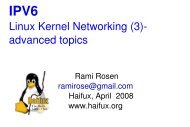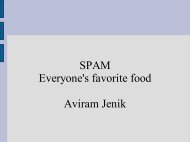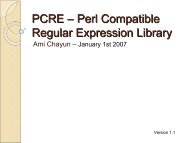TCL: Tool Command Language Tk: (GUI) Toolkit
TCL: Tool Command Language Tk: (GUI) Toolkit
TCL: Tool Command Language Tk: (GUI) Toolkit
You also want an ePaper? Increase the reach of your titles
YUMPU automatically turns print PDFs into web optimized ePapers that Google loves.
<strong>TCL</strong>: <strong>Tool</strong> <strong>Command</strong> <strong>Language</strong><br />
<strong>Tk</strong>: (<strong>GUI</strong>) <strong>Tool</strong>kit<br />
<strong>Language</strong> for doers<br />
Shimon Panfil, Ph.D<br />
<strong>TCL</strong>: <strong>Tool</strong> <strong>Command</strong> <strong>Language</strong><strong>Tk</strong>: (<strong>GUI</strong>) <strong>Tool</strong>kit – p.1/20
What is Tcl?<br />
Tcl (pronounced tickle) is<br />
extensible<br />
embeddable<br />
multi-platform<br />
scripting language developed by John Ousterhout and<br />
others. For history, comparison etc. visit links:<br />
http://www.tcl.tk<br />
http://icemcfd.com/tcl/comparison.html<br />
<strong>TCL</strong>: <strong>Tool</strong> <strong>Command</strong> <strong>Language</strong><strong>Tk</strong>: (<strong>GUI</strong>) <strong>Tool</strong>kit – p.2/20
Tcl-Python-Perl- ....<br />
1. Tcl/Lisp/Python: A "User" point of view , by Jeffrey<br />
Templon<br />
2. Q: perl vs Tcl: complementary, orthogonal , by Tim<br />
Bunce<br />
3. Why you should not use Tcl , by Richard Stallman<br />
4. Re: Why you should not use Tcl , by John<br />
Ousterhout<br />
5. Re: Why you should not use Tcl , by Wayne Throop<br />
6. Perl Peeves , by Tom Christiansen<br />
7. GNU Extension <strong>Language</strong> Plans , by Richard<br />
Stallman<br />
<strong>TCL</strong>: <strong>Tool</strong> <strong>Command</strong> <strong>Language</strong><strong>Tk</strong>: (<strong>GUI</strong>) <strong>Tool</strong>kit – p.3/20
Tcl: Hello world<br />
#!/usr/bin/tclsh<br />
#hello.tcl<br />
set s "hello world!"<br />
puts "* $s *"<br />
exit 0<br />
#end of hello.tcl<br />
$ ./hello.tcl<br />
* hello world! *<br />
<strong>TCL</strong>: <strong>Tool</strong> <strong>Command</strong> <strong>Language</strong><strong>Tk</strong>: (<strong>GUI</strong>) <strong>Tool</strong>kit – p.4/20
Tcl command<br />
command: command arg1 arg2 arg3 . . .<br />
command is the name of built-in command or Tcl<br />
procedure. Space and tabs separate command and<br />
arguments, eol and ; terminate commands.<br />
grouping: strings inside {. . . } or ". . . " are combined<br />
into single argument<br />
substitution: value of variable or nested command are<br />
taken<br />
Tcl does grouping than substitution and finally call command.<br />
<strong>TCL</strong>: <strong>Tool</strong> <strong>Command</strong> <strong>Language</strong><strong>Tk</strong>: (<strong>GUI</strong>) <strong>Tool</strong>kit – p.5/20
Mathematical expressions<br />
Tcl does not evaluate mathematical expressions, expr<br />
command does the job. It concatenates all arguments into<br />
string and parses it as mathematical expression according<br />
to C-syntax.<br />
#!/usr/bin/tclsh<br />
set a 2.0<br />
set b 2.0<br />
set c [expr $a*$b]<br />
set d $a*$b<br />
puts "$d=$c"<br />
exit 0<br />
<strong>TCL</strong>: <strong>Tool</strong> <strong>Command</strong> <strong>Language</strong><strong>Tk</strong>: (<strong>GUI</strong>) <strong>Tool</strong>kit – p.6/20
Mathematical expressions Cont’d<br />
$ ./2x2.tcl<br />
2.0*2.0=4.0<br />
<strong>TCL</strong>: <strong>Tool</strong> <strong>Command</strong> <strong>Language</strong><strong>Tk</strong>: (<strong>GUI</strong>) <strong>Tool</strong>kit – p.7/20
Substitution and grouping<br />
<strong>Command</strong> line is separated into "words". {. . . }, [. . . ],<br />
". . . " are also "words". Double quotes make grouping<br />
with substitutions Braces make grouping without<br />
substitutions they may nest. If first symbol of the word is<br />
dollar: variable substitution<br />
bracket: command substitution, recursive invocation of<br />
Tcl, [. . . ] is replaced by its result.<br />
brace: Tcl simply strips {}.<br />
backslash: backslash substitution, disables special<br />
meaning of the subsequent symbol<br />
<strong>TCL</strong>: <strong>Tool</strong> <strong>Command</strong> <strong>Language</strong><strong>Tk</strong>: (<strong>GUI</strong>) <strong>Tool</strong>kit – p.8/20
Substitution and grouping cont’d<br />
Tcl always performs a single round of substitutions. If<br />
the result contains variables or nested commands these<br />
are not expanded.<br />
<strong>TCL</strong>: <strong>Tool</strong> <strong>Command</strong> <strong>Language</strong><strong>Tk</strong>: (<strong>GUI</strong>) <strong>Tool</strong>kit – p.9/20
Control structures<br />
if {expr} {<br />
body1<br />
} else {<br />
body2<br />
}<br />
<strong>TCL</strong>: <strong>Tool</strong> <strong>Command</strong> <strong>Language</strong><strong>Tk</strong>: (<strong>GUI</strong>) <strong>Tool</strong>kit – p.10/20
Control structures cont’d<br />
foreach arg $argv {<br />
switch -glob -- $arg {<br />
-v {set Verbose true}<br />
-f* {set FileToRead<br />
[string range $arg 2 end]}<br />
-h {puts stderr $Usage<br />
exit 1}<br />
default {<br />
error "bad argument: $arg"<br />
exit 1}<br />
}<br />
}<br />
<strong>TCL</strong>: <strong>Tool</strong> <strong>Command</strong> <strong>Language</strong><strong>Tk</strong>: (<strong>GUI</strong>) <strong>Tool</strong>kit – p.11/20
Control structures cont’d<br />
set n 5<br />
set result 1<br />
for {set i $n} {$i} {incr i -1} {<br />
set result [expr $result * $i]<br />
}<br />
set fd [open "foo" "r"]<br />
while {[gets $fd line] != -1} {<br />
puts "$line"<br />
}<br />
<strong>TCL</strong>: <strong>Tool</strong> <strong>Command</strong> <strong>Language</strong><strong>Tk</strong>: (<strong>GUI</strong>) <strong>Tool</strong>kit – p.12/20
Procedures<br />
proc fact {n} {<br />
set result 1<br />
while {$n>1} {<br />
set result [expr $result * $n]<br />
set [expr $n -1]<br />
}<br />
return $result<br />
}<br />
<strong>TCL</strong>: <strong>Tool</strong> <strong>Command</strong> <strong>Language</strong><strong>Tk</strong>: (<strong>GUI</strong>) <strong>Tool</strong>kit – p.13/20
Procedures cont’d<br />
upvar old new creates variable new in procedure which<br />
is actually variable old which exist outside the procedure.<br />
uplevel command execute command in the calling context<br />
of procedure. Actually both upvar and uplevel take additional<br />
argument pointing the exact level in the execution<br />
stack we want to reference.<br />
<strong>TCL</strong>: <strong>Tool</strong> <strong>Command</strong> <strong>Language</strong><strong>Tk</strong>: (<strong>GUI</strong>) <strong>Tool</strong>kit – p.14/20
Tcl features<br />
Tcl supports a lot of functions for<br />
string processing<br />
list processing<br />
arrays (key–value pairs) processing<br />
It also supports error trapping, sockets, namespaces,<br />
packages and all that.<br />
<strong>TCL</strong>: <strong>Tool</strong> <strong>Command</strong> <strong>Language</strong><strong>Tk</strong>: (<strong>GUI</strong>) <strong>Tool</strong>kit – p.15/20
Tcl Extensions<br />
It is quite easy to incorporate Tcl into your own<br />
programs, you need to link your own functions with Tcl<br />
library to create your own Tcl interpreter that is tailored<br />
to your specific needs.<br />
You can also extend the functionality of Tcl. A number<br />
of such extensions are well known e. g.:<br />
expect: automatic control of interactive programs;<br />
popular dejaGnu test software is written on top of<br />
expect.<br />
incr Tcl: OO extension of Tcl<br />
TcX: extended Tcl for UNIX,contains many functions<br />
mirroring system calls<br />
<strong>TCL</strong>: <strong>Tool</strong> <strong>Command</strong> <strong>Language</strong><strong>Tk</strong>: (<strong>GUI</strong>) <strong>Tool</strong>kit – p.16/20
Tcl extensions cont’d<br />
Img: image processing<br />
<strong>Tk</strong>: <strong>Tk</strong> bestows on Tcl the ability to create and<br />
manipulate <strong>GUI</strong> objects. Initially developed for X<br />
Window system it has been successfully ported to<br />
other platforms.<br />
<strong>TCL</strong>: <strong>Tool</strong> <strong>Command</strong> <strong>Language</strong><strong>Tk</strong>: (<strong>GUI</strong>) <strong>Tool</strong>kit – p.17/20
<strong>Tk</strong> Hello world<br />
#!/usr/bin/wish -f<br />
set b [button .b \<br />
-text "hello world" \<br />
-command exit]<br />
pack $b<br />
<strong>TCL</strong>: <strong>Tool</strong> <strong>Command</strong> <strong>Language</strong><strong>Tk</strong>: (<strong>GUI</strong>) <strong>Tool</strong>kit – p.18/20
Tcl/<strong>Tk</strong> applications<br />
<strong>Tk</strong>DVI is a DVI previewer built with the Tcl/<strong>Tk</strong> toolkit.<br />
http://tkdvi.sourceforge.net/<br />
<strong>Tk</strong>VNC is a VNC viewer written in pure Tcl/<strong>Tk</strong>. It is<br />
designed to be embedded inside other applications,<br />
but can be used as a standalone VNC viewer.<br />
http://www.ifost.org.au/Software/tkvnc/index.html<br />
Xpvm is a <strong>TCL</strong>/TK based tool that allows full<br />
manageability of the PVM cluster as well as the<br />
ability to monitor cluster performance.<br />
http://www.csm.ornl.gov/pvm/<br />
<strong>TCL</strong>: <strong>Tool</strong> <strong>Command</strong> <strong>Language</strong><strong>Tk</strong>: (<strong>GUI</strong>) <strong>Tool</strong>kit – p.19/20
My Tcl/<strong>Tk</strong> applications<br />
I use Tcl/<strong>Tk</strong> mainly as<br />
glue language: to combine a number of independent<br />
computational programs (which I write in C) e. g.<br />
Monte Carlo photon simulations and<br />
thermodynamic calculations;<br />
<strong>GUI</strong>: to set a lot of parameters in a less error prone way;<br />
Data Viewer: to represent 3d numerical data in human<br />
understandable form.<br />
<strong>TCL</strong>: <strong>Tool</strong> <strong>Command</strong> <strong>Language</strong><strong>Tk</strong>: (<strong>GUI</strong>) <strong>Tool</strong>kit – p.20/20



